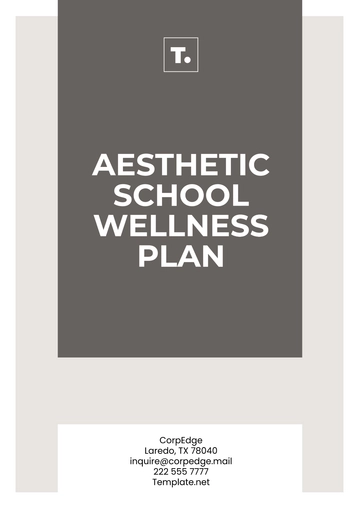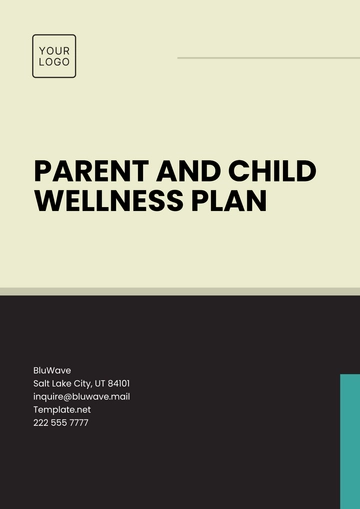Free Gluten-Free Design Wellness Plan

Prepared by: [Your Name]
Company: [Your Company Name]
Date: [Insert Date]
I. Introduction
The Gluten-Free Design Wellness Plan is tailored for individuals who need to manage a gluten-free lifestyle due to medical reasons such as celiac disease, gluten sensitivity, or a desire to promote overall health and well-being. This plan focuses on integrating gluten-free eating and living into daily routines while promoting optimal health, physical vitality, and emotional balance.
This plan incorporates nutrition, lifestyle, mental wellness, and supportive design principles, ensuring that individuals maintain a high quality of life while embracing a gluten-free approach.
II. Vision and Goals
A. Vision
To empower individuals to live a balanced, fulfilling, and healthy gluten-free lifestyle, integrating nutritious eating habits, mindful living, and a supportive environment.
B. Goals
Promote Physical Health: Ensure that individuals achieve and maintain a well-balanced, gluten-free diet that supports optimal health and prevents nutritional deficiencies.
Enhance Emotional Well-being: Manage the emotional aspects of living gluten-free by cultivating self-care practices, mindfulness, and stress management.
Create a Supportive Environment: Design home and work spaces that promote health, comfort, and easy gluten-free living.
Foster Social Integration: Encourage participation in social events and activities that support a gluten-free lifestyle, reducing feelings of isolation.
Maintain Independence: Enable individuals to take control of their health and wellness by equipping them with tools and resources to confidently live gluten-free.
III. Key Areas of Focus and Strategies
A. Nutrition and Physical Wellness
Strategies:
Adopt a Balanced Gluten-Free Diet: Ensure that all meals and snacks are rich in essential nutrients such as fiber, protein, vitamins, and minerals without compromising on flavor or variety.
Goal: Include whole grains (like quinoa, brown rice, and oats), fruits, vegetables, legumes, lean proteins, and healthy fats in every meal.
Avoid Gluten Cross-Contamination: Make sure all food is prepared and stored safely to avoid any contact with gluten. This includes using separate utensils, cutting boards, and kitchen appliances.
Goal: Follow strict protocols for food preparation and serving to avoid gluten exposure.
Supplementation: For those on a gluten-free diet, ensure essential vitamins and minerals such as iron, calcium, and vitamin D are included, as they may be more difficult to obtain in a gluten-free diet.
Goal: Consult with a nutritionist to discuss supplementation needs.
Stay Hydrated: Adequate water intake supports digestion, energy levels, and overall wellness.
Goal: Aim for 6-8 cups of water per day, or more if physically active.
Exercise: Incorporate regular physical activity to support overall health, improve mood, and reduce stress.
Goal: Engage in at least 30 minutes of moderate exercise, such as walking, swimming, or yoga, 3-4 times a week.
B. Emotional Wellness and Stress Management
Strategies:
Embrace the Gluten-Free Lifestyle with Positivity: Develop a positive relationship with gluten-free living by focusing on the health benefits and new food opportunities it offers.
Goal: Engage in self-compassion and reframe challenges into opportunities for health improvement.
Mindfulness and Meditation: Reduce stress and promote mental clarity through mindfulness practices.
Goal: Spend 10-20 minutes per day practicing mindfulness or meditation.
Emotional Support: Acknowledge the emotional toll that adjusting to a gluten-free lifestyle may have and seek emotional support when needed.
Goal: Participate in support groups or seek therapy if feelings of frustration, isolation, or stress arise.
Relaxation Techniques: Implement techniques such as deep breathing, aromatherapy, or progressive muscle relaxation to manage stress effectively.
Goal: Incorporate at least one relaxation practice into daily routines.
C. Social Integration and Support
Strategies:
Educate Family and Friends: Help others understand the gluten-free lifestyle, and share information to reduce misunderstandings or concerns.
Goal: Host a gluten-free cooking class or share articles on the benefits of gluten-free eating with loved ones.
Socialize with Confidence: Attend social events without feeling the need to compromise your dietary needs. Prepare gluten-free meals or snacks in advance to bring to gatherings.
Goal: Plan for parties, holidays, or family events by offering to bring a gluten-free dish.
Join a Gluten-Free Community: Participate in online forums, local meet-ups, or gluten-free support groups to connect with others.
Goal: Find one social group or community event per month to build connections with others who live gluten-free.
D. Home and Work Environment Design
Strategies:
Create a Gluten-Free Kitchen: Set up a designated gluten-free cooking space by using separate utensils, cookware, and pantry items to avoid cross-contamination.
Goal: Ensure your kitchen space is organized and safe for gluten-free food preparation.
Gluten-Free Product Storage: Clearly label gluten-free products to ensure easy access and prevent any confusion with non-gluten-free items.
Goal: Maintain an organized and well-stocked pantry with labeled gluten-free ingredients.
Workplace Wellness: Create a work environment that accommodates gluten-free dietary needs by planning for gluten-free snacks and meal options during meetings and events.
Goal: Speak to employers or colleagues about accommodating gluten-free needs during workplace events, or bring your gluten-free options.
E. Self-care and Routine Wellness
Strategies:
Skin and Hair Health: Many gluten-free individuals experience changes in skin and hair due to nutrient absorption. Incorporate a skincare routine that focuses on hydration and nourishment.
Goal: Use gluten-free skincare products and consult with a dermatologist if any skin or hair issues arise.
Regular Health Check-Ups: For those with celiac disease or gluten sensitivity, ensure regular doctor visits to monitor nutrient levels and overall health.
Goal: Schedule annual check-ups and tests to assess any deficiencies, including blood work to check iron, calcium, and vitamin D levels.
Mindful Eating: Pay attention to hunger and fullness cues to avoid overeating and maintain a balanced diet.
Goal: Practice mindful eating at every meal, focusing on how food makes you feel and nourishing your body.
IV. Implementation Plan
A. Roles and Responsibilities
Healthcare Providers: Ensure proper monitoring of health through regular check-ups and offer nutritional guidance specific to a gluten-free diet.
Nutritionists: Work with individuals to create meal plans and ensure they are receiving the necessary vitamins and minerals.
Support Groups: Offer emotional support through meetings and online communities.
Employers: Provide workplace accommodations for gluten-free individuals, including offering gluten-free options for meetings and events.
B. Timeline
Phase 1 (Months 1-3): Begin by educating yourself on gluten-free living, organizing your kitchen, and establishing a balanced meal plan.
Phase 2 (Months 4-6): Strengthen social connections by participating in gluten-free events and communities while continuing to refine your diet and self-care routines.
Phase 3 (Months 6-12): Focus on long-term wellness by making the gluten-free lifestyle a sustainable part of your daily routine, incorporating mindfulness, relaxation, and social support.
Ongoing (12+ months): Maintain regular check-ins with healthcare providers, monitor your health, and continue to improve your emotional and physical wellness.
V. Evaluation and Monitoring
A. Key Performance Indicators (KPIs)
Physical Health: Improved energy levels, stable weight, and nutritional balance.
Emotional Health: Increased feelings of confidence, emotional stability, and support.
Social Wellness: Greater engagement in social activities without feelings of isolation or inconvenience.
Environmental Wellness: Safe, organized kitchen and workspace.
Lifestyle Sustainability: Long-term commitment to gluten-free living without negative impacts on daily life.
B. Methods of Evaluation
Surveys and Self-Reports: Regular check-ins to assess overall well-being and satisfaction with progress.
Health Assessments: Periodic medical tests to monitor for deficiencies or changes in health.
Goal Tracking: Evaluate progress on gluten-free living goals, including meal planning, socializing, and wellness routines.
VI. Sustainability Plan
A. Ongoing Support
Monthly Wellness Check-ins: Regular check-ins with a health coach or nutritionist to discuss dietary changes, challenges, and progress.
Support Groups and Online Communities: Regularly engage in support groups for continued emotional and practical support.
Continued Education: Stay up-to-date on new gluten-free products, recipes, and health tips to keep the lifestyle fresh and enjoyable.
B. Adjustments
As you continue your gluten-free journey, make adjustments as needed to ensure that the plan remains sustainable, enjoyable, and beneficial. If new health concerns or emotional challenges arise, seek professional guidance and adapt accordingly.
VII. Conclusion
The Gluten-Free Design Wellness Plan is a comprehensive approach to ensuring a healthy, balanced, and supportive gluten-free lifestyle. By focusing on key areas such as nutrition, emotional wellness, social engagement, and home environment design, individuals can confidently embrace gluten-free living and thrive in all aspects of their lives.
- 100% Customizable, free editor
- Access 1 Million+ Templates, photo’s & graphics
- Download or share as a template
- Click and replace photos, graphics, text, backgrounds
- Resize, crop, AI write & more
- Access advanced editor
You may also like
- Finance Plan
- Construction Plan
- Sales Plan
- Development Plan
- Career Plan
- Budget Plan
- HR Plan
- Education Plan
- Transition Plan
- Work Plan
- Training Plan
- Communication Plan
- Operation Plan
- Health And Safety Plan
- Strategy Plan
- Professional Development Plan
- Advertising Plan
- Risk Management Plan
- Restaurant Plan
- School Plan
- Nursing Home Patient Care Plan
- Nursing Care Plan
- Plan Event
- Startup Plan
- Social Media Plan
- Staffing Plan
- Annual Plan
- Content Plan
- Payment Plan
- Implementation Plan
- Hotel Plan
- Workout Plan
- Accounting Plan
- Campaign Plan
- Essay Plan
- 30 60 90 Day Plan
- Research Plan
- Recruitment Plan
- 90 Day Plan
- Quarterly Plan
- Emergency Plan
- 5 Year Plan
- Gym Plan
- Personal Plan
- IT and Software Plan
- Treatment Plan
- Real Estate Plan
- Law Firm Plan
- Healthcare Plan
- Improvement Plan
- Media Plan
- 5 Year Business Plan
- Learning Plan
- Marketing Campaign Plan
- Travel Agency Plan
- Cleaning Services Plan
- Interior Design Plan
- Performance Plan
- PR Plan
- Birth Plan
- Life Plan
- SEO Plan
- Disaster Recovery Plan
- Continuity Plan
- Launch Plan
- Legal Plan
- Behavior Plan
- Performance Improvement Plan
- Salon Plan
- Security Plan
- Security Management Plan
- Employee Development Plan
- Quality Plan
- Service Improvement Plan
- Growth Plan
- Incident Response Plan
- Basketball Plan
- Emergency Action Plan
- Product Launch Plan
- Spa Plan
- Employee Training Plan
- Data Analysis Plan
- Employee Action Plan
- Territory Plan
- Audit Plan
- Classroom Plan
- Activity Plan
- Parenting Plan
- Care Plan
- Project Execution Plan
- Exercise Plan
- Internship Plan
- Software Development Plan
- Continuous Improvement Plan
- Leave Plan
- 90 Day Sales Plan
- Advertising Agency Plan
- Employee Transition Plan
- Smart Action Plan
- Workplace Safety Plan
- Behavior Change Plan
- Contingency Plan
- Continuity of Operations Plan
- Health Plan
- Quality Control Plan
- Self Plan
- Sports Development Plan
- Change Management Plan
- Ecommerce Plan
- Personal Financial Plan
- Process Improvement Plan
- 30-60-90 Day Sales Plan
- Crisis Management Plan
- Engagement Plan
- Execution Plan
- Pandemic Plan
- Quality Assurance Plan
- Service Continuity Plan
- Agile Project Plan
- Fundraising Plan
- Job Transition Plan
- Asset Maintenance Plan
- Maintenance Plan
- Software Test Plan
- Staff Training and Development Plan
- 3 Year Plan
- Brand Activation Plan
- Release Plan
- Resource Plan
- Risk Mitigation Plan
- Teacher Plan
- 30 60 90 Day Plan for New Manager
- Food Safety Plan
- Food Truck Plan
- Hiring Plan
- Quality Management Plan
- Wellness Plan
- Behavior Intervention Plan
- Bonus Plan
- Investment Plan
- Maternity Leave Plan
- Pandemic Response Plan
- Succession Planning
- Coaching Plan
- Configuration Management Plan
- Remote Work Plan
- Self Care Plan
- Teaching Plan
- 100-Day Plan
- HACCP Plan
- Student Plan
- Sustainability Plan
- 30 60 90 Day Plan for Interview
- Access Plan
- Site Specific Safety Plan





























